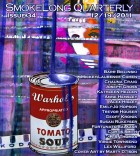She’d punched a boy on the bus. Square in the mouth, once, then again. Her father had to come to the elementary school to get her. In the principal’s office, they watched the surveillance tape. The principal in his suit and tie, her father in his insulated coveralls and rubber boots. The girl with the nurse’s ice bag on her aching hand. The video mesmerized the girl. The image, soundless, unflinching, rendered in sketchy gray, may as well have been the vision of God. Three times they watched it, the principal’s pudgy fingers working the VCR’s buttons. Each viewing added to the image’s immutability. Still, in the girl’s gut, a denial, the realization that one truth wasn’t necessary all truths.
Silence on the ride home. The pickup rattled over narrow roads. The snowy fields rippled with wind-sculpted crests. Not a bird in the sky. Her father’s face gaunt and wind-chapped. Back home, her father sat her at the kitchen table with her books and assignments. His only words—she was to stay put and attend to her studies until lunch. So she completed a math paper and wrote a paragraph about a butterfly’s life cycle. When she was done, she set down her pencil and flexed her swollen hand. She gazed through the frosted window. Outside, her father chopped wood. She worried about the ax, the sharp blade, the cold-slick handle. He swung the ax again. The split wood tumbled. The dull thump lingered in the girl’s chest.
The girl returned to her schoolwork. Word problems, friends sharing apples, how many would each get and how many would be left. The girl rubbed the eraser beneath her chin. She couldn’t think of apples, not now. Outside, another thump of the ax. There was a time when her father’s wood cutting was as steady as the kitchen’s ticking clock, but that was no longer the case.
Her dog lay beside the heater. The girl climbed from the chair and crouched next to the dog. Up close, a gentle hum from the heater, the gassy stink of kerosene. The dog lifted its gray muzzle, sniffed, then lowered its head. Its shaggy tail thumped the floor. She kissed his brow. “Who’s a good boy?” She stroked the dog’s faded coat and thought of the hidden network of tumors that would take the dog before spring. She thought of life at its simplest, the mechanics of heart and lungs, the betrayal of cells.
The door swung open. The girl’s muscles clenched against the cold. The dog struggled to stand, an honoring of its master. Pale red on her father’s cheeks. The scent of wood smoke on his jacket. The girl returned to her seat and picked up her pencil. Her father hadn’t worked since spring. The girl often caught him walking with a steadying hand laid upon walls and countertops. Sometimes she reached over and cut his food; on his face, the expression of a man contemplating a book written in a strange language. “Come with me,” he said.
She grabbed her coat from the back of a kitchen chair. The coat fit snug over her sweatshirt. The cuffs rode above her wrists. On the sleeve, an oil stain from her father’s garage. The boy on the bus had said he wouldn’t wipe his ass with something so ratty. He was about to say more when she filled his mouth with her fist.
The girl and her father stepped outside. A porch of sagging planks, potted geraniums brown and dead. Her breath steamed. The yard’s bare sycamore splintered the gray sky. They stepped into the garage. Clutter all around, naked light bulbs overhead, sawdust on the floor. In the corner, the wood-scrap desk her father had built. Two boxes waited atop the desk. He handed her one and took the other. She followed him back outside.
Ice rimmed the drive’s potholes. The dog’s nails clicked over the gravel. The dog trotted a few steps, slowed, then trotted a few more. Inside the girl’s box, catalogues and newspaper, the rubber-banded stacks of hospital bills they could never hope to pay. The drive rose slightly. The fields her uncles farmed lay buried beneath the snow. The wind blew dry and gritty. White below, gray above. The horizon naked and blurred, a lost boundary.
The girl and her father emptied snow from the rusted barrel. He lifted his box and delivered an avalanche of paper. The girl did the same. A crumpled paper tumbled across the snow. They stomped the boxes flat and shoved them in the barrel. Her father sprayed lighter fluid into the barrel and pulled a box of matches from his pocket. She studied her father’s hands, the blue veins, the nicks and scars of his machinist’s trade. The fingers that had taken apart their pickup’s carburetor now trembled. The motion made the girl think of the clatter of the sycamore’s leafless branches.
The matchbox fell. The girl picked up the box and threw the matches that lay scattered across the snow into the barrel. “Let me,” she said.
She ran the match across the striker. Sparks, a whiff of sulfur. She dropped the match into the barrel.
The flame caught. The dog staggered back on arthritic legs, its snout twitching. The flames burnt red and orange. A column of black smoke twisted toward the clouds. The girl held her hands near the barrel. The warmth felt good in her swollen knuckles. Her father rubbed her shoulder. “Lots of things aren’t fair, sweetheart.”



 The core workshop of SmokeLong Fitness is all in writing, so you can take part from anywhere at anytime. We are excited about creating a supportive, consistent and structured environment for flash writers to work on their craft in a community. We are thrilled and proud to say that our workshop participants have won, placed, or been listed in every major flash competition. Community works.
The core workshop of SmokeLong Fitness is all in writing, so you can take part from anywhere at anytime. We are excited about creating a supportive, consistent and structured environment for flash writers to work on their craft in a community. We are thrilled and proud to say that our workshop participants have won, placed, or been listed in every major flash competition. Community works.